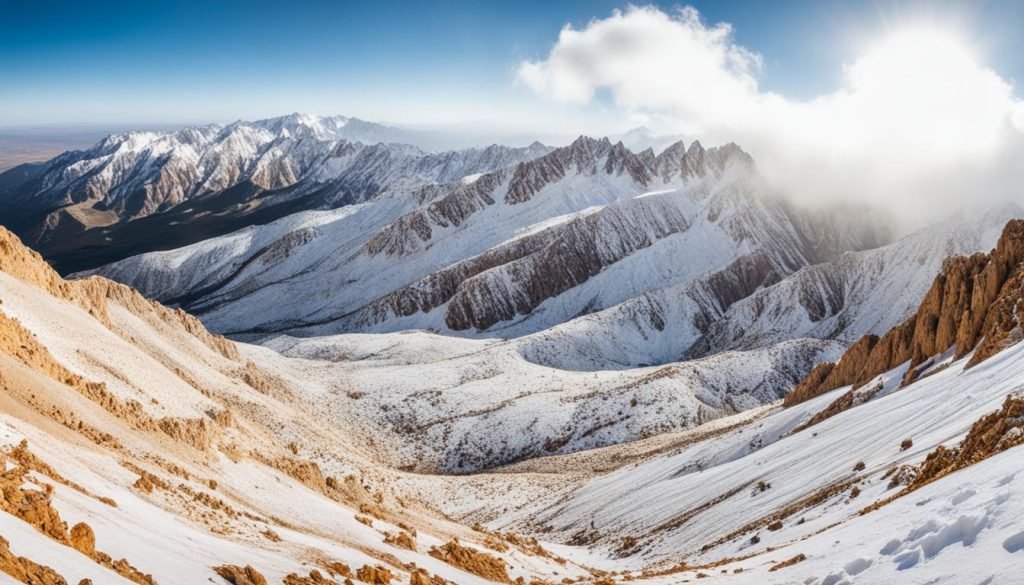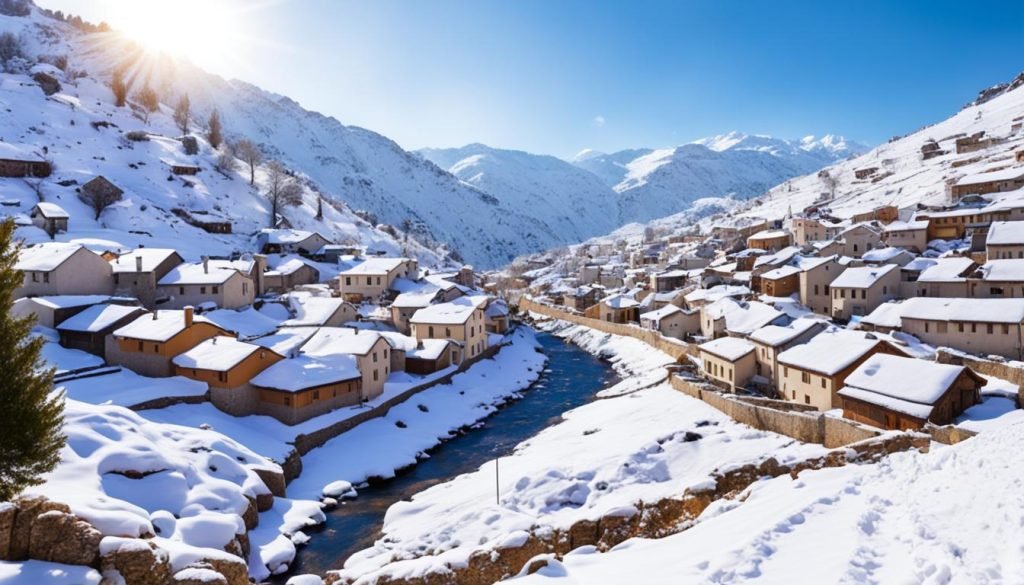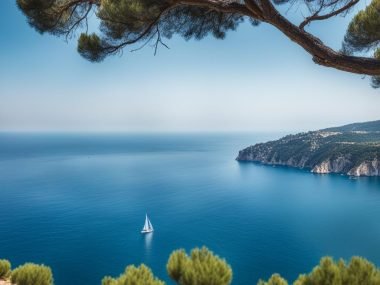Contrary to popular belief, the arid landscapes of North Africa can be adorned with nature’s icy garlands. In fact, Tunisia, a country bathed in sun and renowned for its warm Mediterranean coast, also houses mountainous terrains where the winter weather in Tunisia can get severe enough to cloak its peaks in snow. High up in the Tunisian Dorsal, an extension of the mighty Atlas Mountains, one can witness the rare but enchanting phenomenon of snowfall in Tunisia. These elevated regions bring an unexpected twist to the typical Tunisian climate, offering a winter paradise that comes alive with a surprising dusting of snow. Particularly, Jebel Chambi, Tunisia’s apex at 1,544m, poses as a stark contrast to the deserts below, unraveling the curiosity about does Tunisia get snow?
A closer look at the peaks reveals a story untold by the usual imagery of swaying palms and golden dunes that Tunisia is more commonly known for. When the winter months roll in, and the temperature dips, it is not uncommon for towns like Kesra and the precipitous Jugurtha’s Table to don a surprisingly snowy attire, raising the question among many travelers – does it snow in Tunisia? Indeed, it does, transforming parts of the country into winter wonderlands, albeit temporarily, and certainly worth the awe.
Key Takeaways
- Despite its North African location, Tunisia experiences snowfall in Tunisia during its winter months.
- Jebel Chambi and other high-elevation areas are prime examples of the diverse Tunisia weather patterns.
- The Tunisian Dorsal showcases a scenic, snowy panorama that breaks the stereotype of what Tunisia winter weather typically entails.
- Mountain villages provide a unique travel experience for those keen on discovering whether does Tunisia get snow.
- The occurrence of snow enriches Tunisia’s geographic and climatic diversity, captivating visitors and locals alike.
Tunisia’s Geographical Diversity and Climate Zones
Positioned as the northernmost country in Africa, Tunisia enjoys a significant diversity in its topography and climate that defy the monolithic image of a sun-soaked Mediterranean coast or an expansive Saharan Desert. The complexity of Tunisia’s geographical diversity adds multiple layers to its environmental narrative, painting a varied tapestry that includes mountainous regions, plains, and sea cliffs each fostering its own weather systems and ecological dynamics.
Central to Tunisia’s rich climatic tapestry is the Tunisia climate, which sees a remarkable transition from the moderate Mediterranean weather on the coastal fringes to the more extreme conditions displayed in its central and southern reaches. This climatic transition not only impacts the Tunisia precipitation patterns but also the lifestyle and agriculture of each distinct region.
The Tunisian Dorsal and Snow-Capped Peaks
One of the most striking components of Tunisia’s geographical diversity is the Tunisian Dorsal, an extension of the grand Atlas mountain range. This ridge is home to scores of peaks that rise past the 1,000-meter mark, which during the winter months, frequently find themselves blanketed in snow. Indeed, the average snow days in Tunisia might be few but the Dorsal regions serve as a picturesque exception, where communities witness a soft, white mantle contrasting sharply with the commonly arid landscape.
Climate Variation Across Tunisia’s Regions
The diversity of Tunisia’s geographical diversity extends beyond its snowy peaks down to various regional climates, which is evident upon traversing the country. Along the northern and eastern coasts, the influence of the Mediterranean Sea ushers in mild winters with substantial rainfall, giving way to the semi-arid interior where precipitation becomes noticeably scant. Further south, the vast openness of the Saharan desert presents another extreme, with intensely hot days and surprisingly cool nights.
Understanding the nuances of Tunisia’s climate zones not only enriches the narrative for travelers and geographers alike but also underscores the adaptability of Tunisia’s inhabitants and ecosystems. From snow-capped peaks to sun-baked dunes, each corner of Tunisia tells a unique story of resilience and adaptation to the distinct climate it beholds.
Exploring Tunisia’s Mountain Ranges and Snowfall
When winter descends upon Tunisia’s mountain ranges, the typically verdant highlands and rugged terrains are transformed into a landscape painted with snow in Tunisia. The northwestern regions, home to impressive elevations like Jebel Serj and Jebel Semmama, are particularly known for their scenic beauty under a blanket of snow. These peaks, soaring over 1,300 meters, offer a stark contrast to the Tunisia winter weather one might expect in an African nation, attracting visitors and outdoor enthusiasts alike.

The allure of a Tunisian winter is not lost on those who venture into the highlands. Here, snowfall is not just a phenomenon but a seasonal spectacle that invites a range of activities from hiking to simply reveling in the serene ambience. The following details encapsulate the wintry experiences to be found in the heart of Tunisia’s snowy retreats:
- Jebel Serj: Known for its lush landscapes that become a winter wonderland.
- Jebel Semmama: Offers treks through snow-laden paths for the adventurous spirit.
- Charming villages: Enhance the exploration with cultural encounters and warm Tunisian hospitality.
As one might gather, the snowy season is a treasured time in Tunisia, casting its highland villages in a picturesque splendor seldom seen in African narratives. For locals and tourists, the snow in Tunisia is a cherished rarity that underscores the diverse climatic personality of the country.
| Destination | Elevation (meters) | Typical Winter Activities |
|---|---|---|
| Jebel Serj | 1,357 | Hiking, Photography, Nature Walks |
| Jebel Semmama | 1,314 | Snow Exploration, Local Village Tours |
| Other Villages | Varies | Cultural Experiences, Traditional Cuisine Sampling |
Thus, the presence of snow in Tunisia serves as an invitation to discover an unseen side of North Africa, far from the sun-scorched sands it is typically associated with. The Tunisia winter weather, brisk and enlivening in the highlands, shapes an unexpected journey for any who seek the thrill of nature’s seasonal artistry.
Witnessing Snow in Tunisia’s Northwestern High Altitudes
While Tunisia is commonly associated with warm Mediterranean breezes and vast desert landscapes, the country also cherishes a lesser-known wintry persona, predominantly in its northwestern highlands. As the winter season descends upon the Khemir mountains, the city of Ain Drahem and the Jendouba governorate undergo a snow-laden metamorphosis, which not only beautifies the terrain but also attracts those intrigued by the anomaly of snowfall in Tunisia.

For those who venture to Tunisia’s high altitudes, the sight of white-capped houses and pines in Ain Drahem is a striking contrast to the golden dunes most synonymous with the nation. The Ain Drahem snow blankets the town, creating serene white landscapes and offering a rare spectacle in this predominantly sunny region. Furthermore, the transformation is not just visual, as temperatures dip sharply compared to the scorching summer months, emphasizing the dramatic seasonal shift that this area experiences.
The Beauty of Ain Drahem During Winter
Amid the peaks of the Khemir mountains, Ain Drahem becomes a winter wonderland during the colder months. With frequent Jendouba snow, the region is a testament to the diversity of climates that can be witnessed within Tunisia. The snowfall adorns the town in a soft, ethereal cloak, inviting both locals and tourists to partake in the seasonal charm, whether that’s through leisurely strolls along snow-draped paths or more adventurous pursuits such as hiking and photography.
Jendouba Governorate’s Snowy Transformation
Similarly, the Jendouba governorate, an area known for its rich history and breathtaking landscapes, sees its rugged hills and valleys crowned with snow. This annual phenomenon provides residents and visitors with a unique opportunity to observe and engage with a landscape that stands in stark contrast to the arid scenery associated with greater Tunisia. The majestic transformation due to the snowfall in Tunisia makes Jendouba a significant point of interest for those seeking to experience the country’s multifaceted nature.
Tunisia Weather Patterns: Understanding Rainfall and Temperature Extremes
With its strategic location in North Africa, Tunisia experiences a rich tapestry of climates due to its varying geographical landscapes. Elements such as Tunisia weather and Tunisia climate not only shape the country’s natural environment but also influence the lifestyle and traditions of its people. From the Mediterranean climate that caresses the coastline to the more extreme desert climate of the south, Tunisia is a nation of diverse weather phenomena.
Mediterranean Climate Along the Coast
The northern coastal regions of Tunisia enjoy a pleasant Mediterranean climate, characterized by warm summers and gentle, wet winters. These conditions foster a rich agricultural sector and have become synonymous with the succulent Tunisian olives and citrus fruits that thrive in such Tunisia precipitation patterns.
Semi-Arid and Desert Climates in Central and Southern Tunisia
In stark contrast, the central and southern parts of Tunisia experience a starkly different weather pattern. Here, the semi-arid and desert climates predominate, bringing about a stark transition from the more temperate zones. Rainfall is a rare luxury, and temperature extremes become a common feature, with scorching hot days giving way to significantly cooler nights.
| Region | Climate Type | Summer | Winter | Annual Precipitation |
|---|---|---|---|---|
| Coastal Areas | Mediterranean | Hot | Warm | Moderate to High |
| Central Tunisia | Semi-Arid | Very Hot | Mild to Cool | Low |
| Southern Tunisia | Desert | Extremely Hot | Cool | Very Low |
This comprehensive look at Tunisia’s weather patterns reveals the varied but harmonious coexistence of environments, ultimately contributing to the nation’s unique charm and the resilience of its inhabitants.
Historical Snowfall in Tunisia: Anomalous or Periodic?
Many might find themselves pondering, “does Tunisia get snow?” when considering the nation’s position within the warm, arid expanses of North Africa. However, Tunisia’s winter weather trends reveal a story that contradicts the common perception. The country’s higher altitudes, particularly in the northwestern mountain ranges, do not just flirt with frost but are periodically graced with glistening snowfalls during winter months. This occurrence, while not as frequent as in temperate zones, is a recurring seasonal highlight that punctuates the year with crisp, snowy scenes.
The historical record of Tunisia snowfall history is indicative of a climatic event that, while not commonplace throughout the entire country, is a regular visitor to its more elevated landscapes. The snow caps that adorn the crests of the Tunisian Dorsal, often surprising visitors, underscore a colder facet of the nation’s weather patterns, demonstrating that its climatic identity is far more complex than a typical Sahara backdrop might suggest. The snow here is akin to an artist’s selective touch of white on an otherwise warm-hued canvas, albeit one that is brushed on periodically with precision by nature’s own hand.
Tunisia winter weather trends further illustrate that the snowfall witnessed in regions like Jebel Chambi, the tallest peak in Tunisia, is far from being an anomaly. Adhering to a seasonal rhythm, snowy days have shaped both the physical terrain and the cultural fabric of these highland communities. From outdoor adventures that turn these peaks into winter wonderlands, to the moments of quiet beauty as snowflakes drift past the traditional architecture, these periods of snowfall create enchanting winter intervals that captivate the imaginations and hearts of all who experience them.







